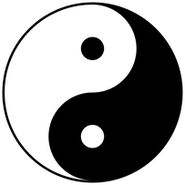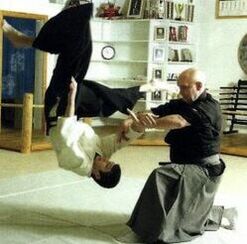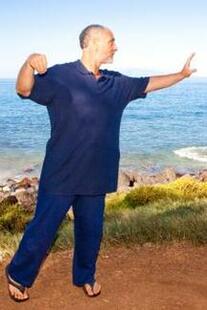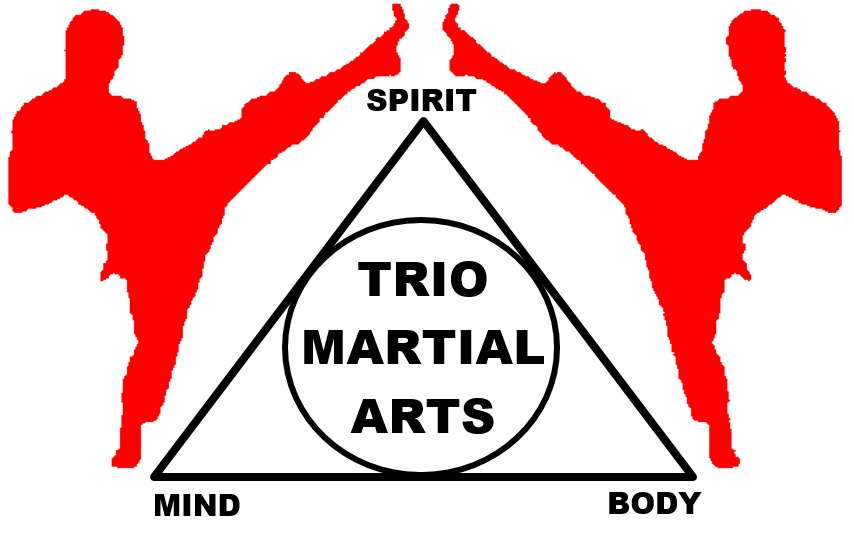 One can hardly engage in any physical endeavor without hearing the term "balance." Depending on the context, this could mean anything from the way your bodyweight is distributed to making sure you're addressing all of your needs on a physical, mental, emotional, psychological and spiritual level. As martial artists, we tend to focus so heavily on the physical aspects of training that we neglect everything else. But as my last article addressed the spiritual refinement in Budo (click here to read), I want to get even deeper. Historically, many of the most prominent martial artists were also healers. They were doctors, bone setters, massage therapists and energy workers. The truth is that these endeavors are not separate from martial arts. Rather they are an extension of them, so much so that to practice martial arts without delving into the healing arts is to never reach mastery. Unfortunately, the Chinese internal martial arts (Taijiquan, Xingyiquan and Baguazhang) seem to be the only arts that prominently feature the healing arts as a staple of their training, to the point that most people ignorantly believe that the classification of an internal martial arts signifies that it is meant solely for healing and not for combative purposes. This couldn't be farther from the truth. In this article, I want to highlight both what it truly means to be an internal martial art, what the healing arts are, and the necessity for studying them as part of your journey of Budo.  Without causing the internet to completely shut down, let me briefly describe what an internal martial art is. Simply put, the classification of "internal" refers to the method of power generation used to execute physical techniques. Internal martial arts specialize in a subtle, "ghostly" power that leaves very little external visual of movement yet the effects of which are clearly seen in the recipient. This can be expressed through striking, joint manipulation or throwing techniques. This power is generated through an advanced understanding of structure and biomechanics that allows you to transmit force without unnecessary physical exertion. Aside from the "Big 3" Chinese internal martial arts listed above, another prominent internal art is Aiki Jujutsu. While there are many branches of Aiki Jujutsu, they all trace back to Daito Ryu and those branches which actually feature the advanced internal material (referred to as Aiki no Jutsu) have certain similarities. Aiki Jujutsu demonstrations often feature spectacular displays of balance tricks where an "attacker" is effortlessly thrown from a simple wrist grab, leading to the misconception that these are self defense techniques. But like many other endeavors in life, especially those of Asian origin, what is being shown is very rarely the true lesson. A staple of internal martial arts training are solo exercises which strengthen the fascia and other soft, connective tissue of the body as well as condition the myofascial meridians to transmit force across the body, leading to what is known as "whole body power" or "focused power." Another common training method of internal styles are sensitivity and connection drills. These drills heighten your ability to recognize and receive force along various planes and vectors so that you can ultimately exploit the weaknesses in your opponent's structure and balance point, disrupting them long enough for you to execute your desired counter attack. That's all they are. Every physical engagement goes through various ranges, and sensitivity drills train you for a specific moment in time, the instant when you come into physical contact with your attacker. They train you to disrupt your attacker's balance from the moment of contact, but disrupting someone's balance doesn't have to result in a spectacular throw. If I can cause a split-second of an opening, a shift in your intent or a quick stumble, there is my opportunity.  So where do the healing arts come into play? The need for basic first aid, up to and including bone setting, should be obvious to anyone who has trained in martial arts. Injuries happen and having the ability to address them instantly can sometimes mean the difference between life and death. Even the need for regular massage is apparent. Therefore, I want to specifically address energy healing (and no, this will not be a "woo woo" article) where I talk about some mystical force. The benefits of Qigong and Reiki have been widely studied and recorded, just a few links to which will be provided at the bottom of this page. The truth is that energy healing has been featured in nearly every indigenous culture (including Native American tribes, where it is commonly called "Healing Hands"), and the foundation for energy healing is a basic human instinct. When you are injured, your first response is to gasp for air thus allowing you to have more oxygen in your bloodstream and you tightly grasp onto the injured area. Very quickly, the spot begins to become warm as blood is directed to the area. The increase in blood flow brings oxygen and nutrients to the area, as well as flushes out any metabolic waste that was created as a result of the injury. This application of heat increases cell metabolism, ultimately promoting healing. The same result is created through various liniments (Dit Da Jow, Tiger Balm, etc.), the only difference being this is done through touch. But that's it. That is the underlying basis of energy healing. In addition to the laying-on of hands as described above, various solo exercises are practiced for self healing. These breathing exercises ultimately stimulate blood flow, carrying oxygen and nutrients throughout the body... See where I'm going with this? Increased circulation leads to improved cardiovascular and respiratory function, as well as all around healthier organ function, leading to a healthier person. And yet these practices are still considered pseudoscience. Ironically, many of these solo exercises are identical to the ones practiced in the internal martial arts for conditioning of the body. It's almost as if the practice of these endeavors was connected. Both Qigong and Reiki can have emotional healing benefits as well. The science on this is a little trickier, but in my opinion it can be boiled down to our basic need for human interaction and comfort. The gentle, caring touch of another person allows us to open up, and gives us a safe space to work through our emotional problems. Ultimately, the Qigong or Reiki practitioner does not heal you. Rather, they open your eyes to your own natural ability to heal yourself. They're just there to hold your hand through the process. However, just as the study of martial arts is meant to include the study of healing, the same is true in reverse. Qigong is just one piece of the Chinese martial arts puzzle, and the founder of Reiki was a Daito Ryu practitioner (coincidence?). Be very weary of those who practice only healing arts, referring to themselves as "healers" or "light workers." As Qigong is taught alongside the "Big 3," let's focus on Reiki.  Unfortunately, Reiki specifically has become one of the most bastardized forms of alternative medicine out there. Students are often rushed through a couple of hours of basics and then unleashed on the world with a shiny new Level 1 certification and absolutely no understanding of what they're doing. Reiki has become all the rage in "new age" circles as well, leading to a large groups of people getting together at festivals reminiscent of the 1960s to discuss healing and other metaphysical topics. A fundamental aspect of the healing arts are the use of chakras, energy centers that run along the vertical line through the body. While "light workers" believe they are maintaining balance and alignment of their chakras, without addressing the physical expressions of connection as in the internal arts, their practice generally revolves around emotional and spiritual healing. Thus, a huge (albeit unconscious) emphasis is placed on the third eye and heart chakras. But as I said, the study of Reiki must come alongside training in the internal martial arts. The subtle power I described above originates in the tanden (dantien in Chinese), which sits just below the naval. This is also the location of the sacral chakra. Without the development of this and the root chakra, it is impossible for someone dealing with energy to ground themselves and be fully balanced. Because Reiki has become so streamlined, the practice of solo conditioning exercises isn't even discussed among most Western practitioners because they were taught them, yet it's these exercises that truly lead to having a connected body. Therefore, an entire aspect of the art is simply missing and you have thousands of "masters" running around putting their hands on people that aren't qualified (this also leads to an epidemic of predators in the healing community, but that's another subject). On a cellular level, we exchange DNA with every person we come in contact with. This is why I make it a point to specifically avoid most people who claim to practice Reiki, unless they're also a student of internal martial arts. It's also why I'm very happy to have studied traditional, Japanese Reiki from outside of the Takata lineage so I can tell the difference. Now, before it starts sounding like I'm bashing the entire practice of Reiki, let me be clear that is not the case. As stated, I am a Reiki practitioner, and just as I care deeply enough about the martial arts to call out illegitimate practices that can be harmful to people, I care about the healing arts and will do the same. Energy work has been a catalyst for some significant changes in my life, and I can personally attest to the benefits of both Reiki and Qigong. With the help of someone who is qualified and knowledgeable (that includes the study of both the martial and healing arts) these practices can be beneficial and, as part of a larger healing program, lead to an improvement in your overall health and well-being. At the end of the day, what it really comes down to is balance. EDIT (January 15, 2019) - I have received numerous emails regarding the healing arts and how to pursue them. Please let me make this very clear. Just as in martial arts, do NOT attempt to study the healing arts or anything dealing with energy without the supervision and direct instruction of a qualified teacher. While there are numerous positive benefits to both Qigong and Reiki, when dealing with people's energy there can be negative side effects as well. Without going into too much detail, suffice it to say that these negative effects have completely changed the trajectory of my own life because I was messing with things I did not understand at the time. Therefore, I cannot express deeply enough the necessity of a qualified instructor when beginning your journey into the healing arts. https://www.uclahealth.org/rehab/workfiles/Urban%20Zen/Research%20Articles/Reiki_Really_Works-A_groundbreaking_Scientific_Study.pdf http://www.aetw.org/reiki_research.html https://www.ncbi.nlm.nih.gov/pmc/articles/PMC3085832/ https://harvardmagazine.com/2010/01/researchers-study-tai-chi-benefits This article was originally published on the US Association of Martial Arts blog. To view the original article, please click here.
0 Comments
Your comment will be posted after it is approved.
Leave a Reply. |


